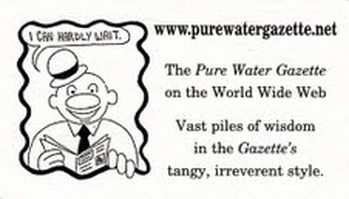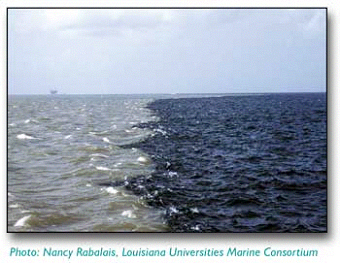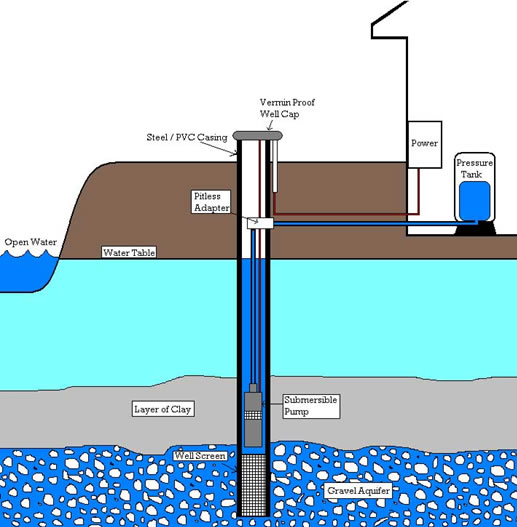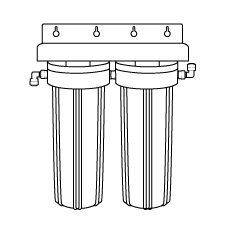Special Mid-Month Issue August 15, 2012 |
|---|
 http://www.purewatergazette.net http://www.purewatergazette.net |
|---|
We hope you'll read the Pure Water Gazette's new "Today's Top Water News" section. New articles appear daily. Some examples of recent posts are included in his issue. |
Our New National Test Labs Page Is Now Online
by Gene Franks
We've just put up a new version of our National Test Labs page. The page features more information about NTL's standard WaterCheck tests, and we've also added the new CityCheck and WellCheck packages, plus a generous list of individual tests that can be added to the standard tests.
Pure Water Products has offered the basic WaterCheck and WaterCheck with Pesticides for a number of years. National Test Labs offers a high quality product that we sell with enthusiasm.
The way the NTL system works is that the customer purchases the basic test kit from us, takes water samples according to the instructions, then mails the samples (overnight) direct to NTL's laboratory in Cleveland. Within a few days, both the customer and Pure Water Products receive a copy of the test result. Having a copy of the test in our files allows us to answer questions about the meaning of the test or suggest treatment if you request it. I underline, if you request it. We don't use the test as a sales tool (as is common in the industry), We won't contact you unless you ask us to. The customer makes only one payment--to us. We pay National Test Labs.
How To Read a Water Test
If you've had the experience of finding yourself bewildered by the printed results of a water test, you'll love the National Test Lab Tests. NTL uses a clearly explained, color-coded report format that highlights problem areas and gives complete information about national standards and how your water compares.
If you'll take a look at this sample report form from the standard WaterCheck test, I'll give you a quick explanation of what it means.
Left Column: Status
The left column gives a quick, color-coded report on the final status of the contaminant or issue being tested.
Green Check means that the analyte (the item being tested) was not found in your sample.
Blue Dot means that the item was detected but at a level deemed acceptable.
Yellow Triangle means that the item was detected at a level above the EPA's recommended maximum, but that the limit is not "enforceable." In practical terms, this means that the water has more than a desirable amount of the contaminant, but the issue isn't a threat to health. In the sample test, the suggested limit for manganese has been exceeded, but the standard for manganese is not an EPA "enforceable" issue.
Red Cross designates a serious health-threatening issue that should be corrected. Arsenic on the sample is slightly above the enforceable EPA standard and is marked with the Red Cross.
Second Column: Contaminant
This column simply names the contaminant or water issue being tested. Note that items in this column are divided into several categories, beginning with Microbiologicals and including Inorganics, Organics, Physical Factors, etc. The very top category, Microbiobiolocals, tests the water for the general Coliform family of bacteria, and if Coliform are found, the more specific test for for E. coli is performed. In the sample test, since Total Coliform was not detected, there was no point in testing for E. coli.
Third Column: Results
This column gives the numerical result of the test, in the denomination (in most cases mg/L) specified in the Fourth Column. ND means not detected.
Fourth Column: Units
A great advantage of the NTL tests is that all contaminants are reported in mg/L (milligrams per liter, which is the same as PPM or parts per million). Many labs report in whatever is convenient for the lab, mixing parts per million and parts per billion. The single unit method used by NTL puts things in perspective and makes it much easier to interpret test results.
Note that physical factors of the water are reported in special terms: pH, for example, is reported in the standard 1-14 pH scale and turbidity is reported with the widely used NTU scale.
Fifth and Sixth Columns: National Standards
Perhaps the least understood part of most water test reports is the meaning of National Standards and the qualifying categories (EPA Primary, EPA Secondary, EPA Action Level). It isn't as complicated as it sounds.
The number in column five is the highest amount that is acceptable. Aluminum on the test has a standard of 0.2 mg/L. This means that at 0.2 mg/L aluminum starts being considered an issue. The qualifying description, EPA Secondary, means that the number is a guideline, a suggestion, not an enforceable limit. There is no adverse health effect associated with water containing more that 0.2 mg/L of aluminum.
The EPA Primary designation of Arsenic at 0.01 mg/L means that at 0.01 mg/L arsenic has an EPA established MCL (Maximum Contaminant Level) that is enforceable. The MCL number is the highest amount of the contaminant that is allowed in drinking water. "Action Level" designations (as with lead) are primary standards with enforceable MCLs that are defined with required treatment techniques. For practical purposes, unless you are manager of a municipal water system, the distinction between EPA Primary and EPA Action Level designations is of no concern. What is important is to understand that either is a designation that requires immediate attention.
Right Column: Minimum Detection Level
MDL is simply the smallest amount of the analyte that the test is able to detect. The 0.004 MDL for manganese means that the test is unable to detect manganese in amounts below 0.004 mg/L. An ND level does not mean that the item is totally absent from the sample; it means that if it's there, the amount is less than the MDL figure.
Details about our free tests and the inexpensive National Testing Labs tests are on our main website.
 |
"Dead Zone" in the Gulf. Oxygen-depleted areas caused by human activities like golf courses, suburban lawns, and agriculture. The condition is known as hypoxia. |
EPA Is Providing Funds to Reduce Hypoxia in the Gulf of Mexico
The EPA has just issued a grant to the Louisiana Coastal Protection and Restoration Authority for the purpose of combating hypoxia.
A large area in the northern Gulf of Mexico is called the “dead zone.” The problem is known technically as hypoxia. Hypoxia means low oxygen and is primarily a problem in coastal waters. The Gulf of Mexico dead zone is an area of hypoxic waters at the mouth of the Mississippi River. Its area varies in size, but can cover up to 6,000 to 7,000 square miles. The dead zone is caused by nutrient enrichment from the Mississippi River, particularly nitrogen and phosphorous.
Hypoxic waters have dissolved oxygen concentrations of less than 2-3 ppm. Hypoxia can be caused by a variety of factors, including excess nutrients, primarily nitrogen and phosphorus, which promote growth of algae. As dead algae decompose, oxygen is consumed in the process, resulting in low levels of oxygen in the water.
Nutrients can come from many sources, including any of the following:
- Fertilizers from agriculture, golf courses, and suburban lawns
- Erosion of soil full of nutrients
- Discharges from sewage treatment plants
- Deposition of atmospheric nitrogen.
Reprinted from the Pure Water Gazette.
More about the EPA's hypoxia project from the EPA’s Website.
 |
A typical water well. |
How to Keep Your Well Healthy
by Chris Carl
Reprinted from Care2.
Gazette Introductory Note: This excellent overview of water well health is reprinted as a service to our readers. The author points out basics that every well owner should be aware of. Well owners have a responsibility to themselves and to others. When you punch a hole down to the water table, you not only give yourself access to water; you also open an avenue for contaminants to enter the ground water. --Hardly Waite, Gazette Senior Editor.
“Wellhead protection, whether a dug well or artesian, is a top priority in having a healthy well,” said Bart Cushing, owner of Cushing & Sons Dependable Water Wells in Keene, New Hampshire. “Wellhead protection will also solve about eighty percent of any problems you might run into as well,” he added. In the past few decades, wells have gone from being dug two to three feet wide to the more modern six-inch inch width and are primarily artesian and capped with cement.
Your first consideration when contemplating a well on your property is finding a well drilling business that has experience and references. Cushing said that people sometimes think they are saving money by hiring a contractor who is inexpensive and uses cheap, possibly hazardous materials. “I’ve had a lot of business during the recession fixing a lot of these mistakes,” said Cushing.
Once you’ve hired a reputable company you will need to consider:
*Where is the ground water?
*Is the proposed well away from sources of contamination?
*Is the location convenient to power and the building being supplied with water?
*Is the location assessable for drilling and pump installation?
Protecting your well from contaminants
Cushing advised having your well tested at least once a year, suggesting the late spring as the best time to test as that is when there is the most run-off from melting snow.
Cushing said he has been very surprised over the years regarding some of the things people don’t understand about keeping the water in their well healthy. “For example, if gasoline is spilled within one hundred feet of a well and there is enough of a gradient, sure enough, there will be petro chemicals in your well,” said Cushing. Though he added the chemicals could take two to three days to seep into the well.
Cushing noted a few other ill-advised homeowner choices, such as placing a kennel or livestock near your well. “For example, if you have ducks, you are likely to have them by a source of water, which will also likely be close to where you might place a well,” said Cushing. The great danger from having pets and livestock in range of your well is the threat of E. coli. It is also important to take into consideration use of pesticides on your property as well as salt run-off from near-by roadways. “You can filter almost anything,” Cushing said.
“Normal” contaminants in your well
Water in your well can be treated for having high levels of iron or being other high mineral contents that occur naturally depending on where your well has been dug.
Cushing said that in recent years there has been a greater concern regarding radon in water supplies. He said allowable amounts in water vary greatly from state to state, but that radon in your water supply is rarely, if ever a real concern. Cushing said in most cases you’d “have to take a twelve-hour shower for the next ten years to be affected by the amount of radon in your water.”
“Testing (water) has become far more sophisticated over the years,” said Cushing. Arsenic is another naturally occurring substance that is likely to show up during a test, but is rarely in appreciable quantities. Cushing said that arsenic is more likely to show up when you live near a railroad track. “They often treat the rails with arsenic to kill rats,” Cushing said.
If you have concerns regarding contaminants, it is a good idea to have your well tested more frequently.
Early August Water News
The Pure Water Gazette features its pick of the top water news story each day. Here's what you missed in the first half of August if you haven't been reading the Gazette:
The new Gazette format also indexes much of the significant content of the old online and paper versions of the Pure Water Gazette. Take some time to browse. As our ad says, "Vast piles of information in the Gazette's tangy, irreverent style."
Daily water news items are designed to present a concise version of an important water issue with a reference link to more information if you care to pursue it.
 |
|---|
Multi-cartridge drinking water filters are much under-rated. A good undersink double or triple filter can produce very high quality drinking water for many years with maximum convenience, minimum maintenance, and at a cost that is only a fraction of that of bottled water. Undersink filters use neither electricity, like a distiller, nor water, like reverse osmosis, so they’re economical performers with a basic simplicity that makes them almost maintenance-free. Please take a look at our superb line of Black and White undersinks: Standard Units, Complete With Their Own Faucet "Simple" Units That Dispense Water Through Your Existing Cold Water Faucet A Previous Occasional Was Devoted Entirely to Undersink Filters. |
B. Bea Sharper on Swimming
Gazette Numerical Wizard B. Bee Sharper Reveals the Numerical Facts About Swimming that Harper’s Missed |
 |
|---|
Percentage of swimming worldwide that involves water — 100%.
Percentage of Americans who are afraid of swimming pools — around 50%.
Approximate number of drowning deaths that occur each year — 3800.
Approximate number of these drowning deaths that occur in pools –700.
Approximate number of pool-related emergency department treated injuries that occur each year — 5700.
Percentage of Americans who are afraid of deep, open bodies of water, like lakes — around 66%.
Percentage of Americans who are afraid of the deep end of a swimming pool — 46%.
Percentage of American men who say that they are unable to swim — 21%.
Percentage of American women who say that they are unable to swim — 51%.
Percentage of Americans who say that they are unable to swim — 37%.
Percentage of African Americans who say that they are unable to swim — 62%.
Percentage of Caucasian Americans who say that they are unable to swim — 32%.
Percentage of Asian Americans who say that they are unable to swim — 47%.
Percentage of Hispanic Americans who say that they are unable to swim — 44%.
Rank of drowning as cause of unintentional injury and death in children 1 to 19 — 2.
Factor by which 5 to 19 year old African American children are more likely to drown in a swimming pool than their peers — 6 times.
Percentage reduction in drowning of 1 to 4 year old children which can be attributed to formal swimming lessons –88%.
Reference Source: “More Swimmers Will Result in a Healthier Society, Fewer Drownings and Reduced Healthcare Costs, ” by Thomas Lachocki, Ph. D.. Paper commissioned by the National Swimming Pool Foundation and reprinted in Water Conditioning and Purification Magazine, August, 2012,
Editor’s Note: B. Bea Sharper, a big swimming pool fan, was not bothered that the numerical facts for this piece came from the National Swimming Pool Foundation, but the whole thing seemed a bit awkward to me. The point being made, if I understood the article, is that you should get yourself a swimming pool so you can learn to swim so you won’t drown in a swimming pool. Or that African Americans especially should get a pool because their children are six times more likely than “their peers” to drown in a pool. Isn’t this a little like saying you should get your child a gun because this will make him less likely to have a gun accident? And as for the 46% of Americans who are afraid of the deep end of a swimming pool, they need to put in a pool so they can overcome their fear of the deep end of the pool. There’s a lesson here somewhere, but I’m missing it. –Hardly Waite, Pure Water Gazette.
The Pure Water Occasional is a project of Pure Water Products. Please visit our websites: Main Website: www.purewaterproducts.com This site features our full range of products, plus instructions, technical articles, product manuals, and more. The Occasional's Website: www.purewateroccasional.net. In addition to archiving back issues of the email Occasional, this site houses a sizeable section about water contaminants, a "how things work," series, a new products section, a glossary of water treatment terms, and, "much, much more." Other Pure Water Products Sites: www.purauv.com To contact us by phone, please call 940 382 3814.
|
|---|